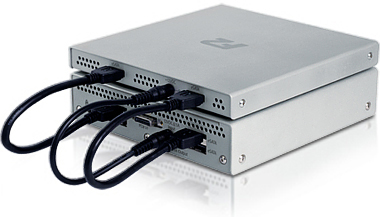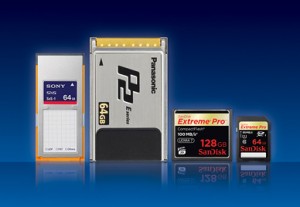New from Sonnet Technologies is the Qio (pronounced “KEE-oh” not like the Pidgin English “CHEE-oh”). Qio is a device that reads and writes all the current memory chips that are used in video cameras and online editing systems.
After you hook up one or more Qios to your computer – using the supplied peripheral interface card and cables – you can relegate your camera to the field and stop using it to download your dailies and archive your final edits. Qio is platform agnostic, and works equally well with MAC or PC platforms.
You can also throw away all your USB card readers because Qio provides immediate compatibility with Sony® SxS, Panasonic® P2, CompactFlash, SDHC and SDXC cards (using an included adapter). The PCI Express bus interface provides a wider bandwidth of 200MB/sec. throughput, eliminating most of the delay imposed by USB transfers.
Some newer computers, like the HPZ-800 offer an integrated memory card reading panel as an option, but Qio is much more than this for its $999 price tag.
 For instance, if you’d like to take advantave of the faster SATA drive format, Qio’s integrated, fast SATA host controller (based on Tempo SATA E4P) with four eSATA ports supports and powers two Fusion F2 SATA storage systems, or supports SATA drive enclosures with up to 16 drives total. For large volume acquisition and storage, you can loop-connect multiple Qios.
For instance, if you’d like to take advantave of the faster SATA drive format, Qio’s integrated, fast SATA host controller (based on Tempo SATA E4P) with four eSATA ports supports and powers two Fusion F2 SATA storage systems, or supports SATA drive enclosures with up to 16 drives total. For large volume acquisition and storage, you can loop-connect multiple Qios.
The cables are long enough to allow your Qio cabinet to sit conveniently on top of your computer or desk and the aluminum case measures just 5.9″ x 6.2″ x 1.22″. Theft of the unit is deterred by standard Kensington style security slots.

Qio supports a full range of media cards such as (from left to right) Sony SxS, Panasonic P2, CompactFlash, and SDHC cards.
We installed a Qio on an older dual Pentium-4 machine which, until now, had been using a cheap USB card reader device which of could not read the P2 cards. With all our camera media, the data showed up much faster than with the USB (and, presumably with FireWire), and laybacks to the chips for storing final edits and selected takes. The results have driven us to decide to install it on the faster machines which are already equipped with card readers, to see if the increase in speed will carry over to them as well. More news on that when I have it!

 LinkedIn
LinkedIn YouTube
YouTube